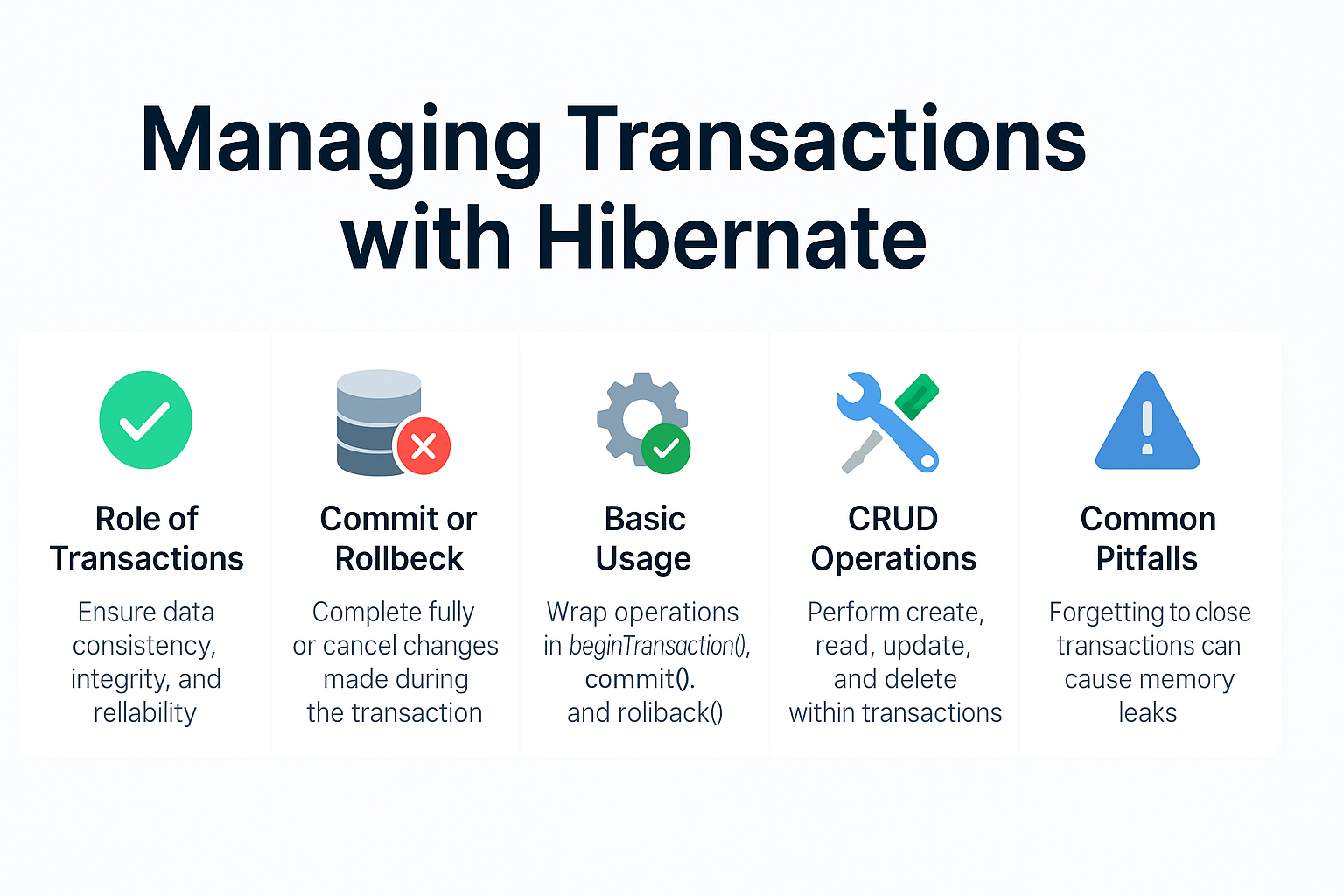In modern Java applications, transactions play a vital role in ensuring data consistency, integrity, and reliability. When working with relational databases, developers must ensure that multiple operations either succeed or fail together. This is where Hibernate’s transaction management becomes crucial.
Think of a transaction like buying groceries—you either pay for all items at once, or you don’t get any of them. Similarly, in Hibernate, a transaction ensures all database operations are atomic, consistent, isolated, and durable (ACID principles).
Hibernate simplifies transaction handling by abstracting JDBC complexities and providing an easy API to work with transactions.
What is a Transaction in Hibernate?
A transaction is a logical unit of work that either completes fully (commit) or does not happen at all (rollback).
- Commit → Saves changes permanently to the database.
- Rollback → Cancels changes made during the transaction.
Hibernate provides org.hibernate.Transaction interface to manage database transactions.
Hibernate Setup for Transactions
Maven Dependencies
<dependencies>
<dependency>
<groupId>org.hibernate.orm</groupId>
<artifactId>hibernate-core</artifactId>
<version>6.2.7.Final</version>
</dependency>
<dependency>
<groupId>mysql</groupId>
<artifactId>mysql-connector-j</artifactId>
<version>8.0.33</version>
</dependency>
<dependency>
<groupId>org.postgresql</groupId>
<artifactId>postgresql</artifactId>
<version>42.6.0</version>
</dependency>
</dependencies>
Hibernate Configuration (hibernate.cfg.xml)
<hibernate-configuration>
<session-factory>
<property name="hibernate.connection.driver_class">com.mysql.cj.jdbc.Driver</property>
<property name="hibernate.connection.url">jdbc:mysql://localhost:3306/hibernatedb</property>
<property name="hibernate.connection.username">root</property>
<property name="hibernate.connection.password">password</property>
<property name="hibernate.dialect">org.hibernate.dialect.MySQL8Dialect</property>
<property name="hibernate.hbm2ddl.auto">update</property>
<property name="hibernate.show_sql">true</property>
</session-factory>
</hibernate-configuration>
Entity Class Example
import jakarta.persistence.*;
@Entity
@Table(name = "users")
public class User {
@Id
@GeneratedValue(strategy = GenerationType.IDENTITY)
private Long id;
@Column(nullable = false)
private String name;
@Column(nullable = false, unique = true)
private String email;
// Getters and Setters
}
Transaction Management in Hibernate
Basic Transaction Usage
import org.hibernate.Session;
import org.hibernate.SessionFactory;
import org.hibernate.Transaction;
import org.hibernate.cfg.Configuration;
public class TransactionExample {
public static void main(String[] args) {
SessionFactory factory = new Configuration().configure("hibernate.cfg.xml").buildSessionFactory();
Session session = factory.openSession();
Transaction tx = null;
try {
tx = session.beginTransaction();
User user = new User();
user.setName("John Doe");
user.setEmail("john@example.com");
session.save(user); // Create operation
tx.commit(); // Commit transaction
} catch (Exception e) {
if (tx != null) tx.rollback(); // Rollback on failure
e.printStackTrace();
} finally {
session.close();
factory.close();
}
}
}
CRUD with Transactions
Create
session.save(new User("Alice", "alice@example.com"));
Read
User user = session.get(User.class, 1L);
System.out.println(user.getName());
Update
user.setName("Updated Name");
session.update(user);
Delete
session.delete(user);
Querying with Transactions
Using HQL
List<User> users = session.createQuery("FROM User", User.class).list();
Using Criteria API
CriteriaBuilder cb = session.getCriteriaBuilder();
CriteriaQuery<User> cq = cb.createQuery(User.class);
Root<User> root = cq.from(User.class);
cq.select(root);
List<User> result = session.createQuery(cq).getResultList();
Using Native SQL
List<Object[]> results = session.createNativeQuery("SELECT * FROM users").list();
Real-World Use Case: Spring Boot + Hibernate Transaction
In Spring Boot, transactions are often managed using the @Transactional annotation.
@Service
public class UserService {
@Autowired
private UserRepository userRepository;
@Transactional
public void registerUser(User user) {
userRepository.save(user);
}
}
Spring takes care of transaction lifecycle automatically, reducing boilerplate code.
Common Pitfalls in Transaction Management
- ❌ Forgetting to close transactions → leads to memory leaks.
- ❌ Using Eager fetching unnecessarily → causes N+1 select issues.
- ❌ Long transactions → can cause locking and performance degradation.
- ❌ Not handling rollback properly → leads to inconsistent state.
Best Practices
✅ Always close transactions in finally block.
✅ Prefer short-lived transactions for performance.
✅ Use @Transactional with Spring to simplify code.
✅ Choose lazy loading where appropriate.
✅ Monitor SQL queries to detect N+1 select issues.
📌 Hibernate Version Notes
-
Hibernate 5.x
SessionFactorysetup usingConfiguration().configure()- Legacy transaction APIs
-
Hibernate 6.x
- Moved to Jakarta Persistence API (
jakarta.persistence) - Enhanced SQL query support
- More powerful
CriteriaBuilder - Simplified bootstrap process
- Moved to Jakarta Persistence API (
Conclusion & Key Takeaways
- Transactions ensure data consistency and follow ACID principles.
- Hibernate provides easy APIs for commit and rollback.
- Integration with Spring Boot makes transaction handling simpler.
- Use best practices like short-lived transactions, lazy loading, and caching.
- Avoid pitfalls like N+1 select problems and misusing eager fetching.
FAQ
Q1. What’s the difference between Hibernate and JPA?
Hibernate is an implementation of JPA but also provides advanced features beyond the JPA specification.
Q2. How does Hibernate caching improve performance?
By storing frequently accessed entities in memory, reducing database calls.
Q3. What are the drawbacks of eager fetching?
It loads all related entities immediately, which may cause performance issues.
Q4. How do I solve the N+1 select problem in Hibernate?
Use JOIN FETCH, batch fetching, or second-level caching.
Q5. Can I use Hibernate without Spring?
Yes, you can manage SessionFactory and transactions manually.
Q6. What’s the best strategy for inheritance mapping?
Depends on use case—SINGLE_TABLE for performance, JOINED for normalization.
Q7. How does Hibernate handle composite keys?
With @Embeddable and @EmbeddedId annotations.
Q8. How is Hibernate 6 different from Hibernate 5?
Hibernate 6 uses jakarta.persistence namespace and enhanced SQL support.
Q9. Is Hibernate suitable for microservices?
Yes, but keep transactions short and consider stateless design.
Q10. When should I not use Hibernate?
When you need extreme performance with hand-optimized SQL or simple applications with minimal database logic.
